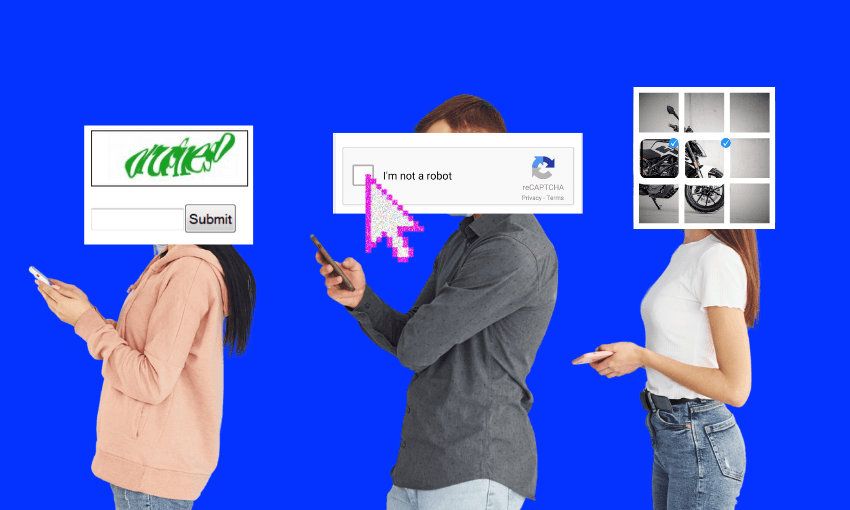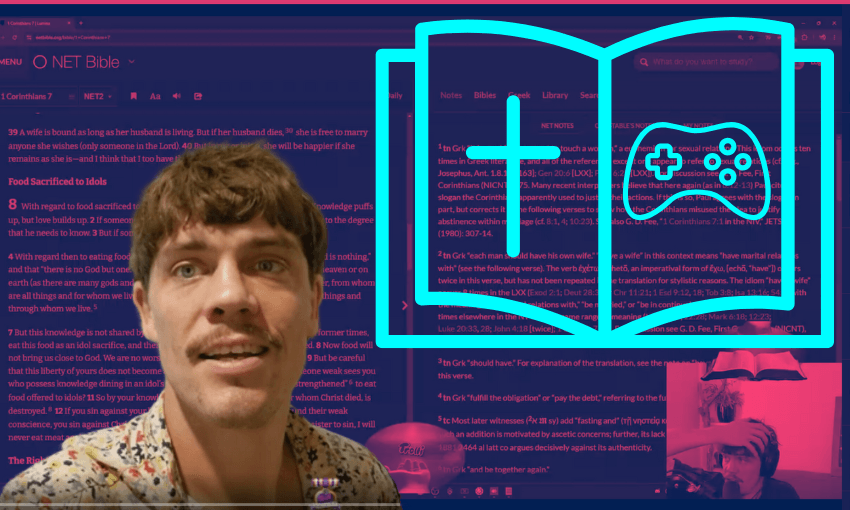They are a frequent, frustrating experience in a society that puts digital technology first. But while finding all the traffic lights in a grainy image is irritating, for many New Zealanders it prevents them from accessing the site at all.
At least four or five times in a standard week, I have to fill out a CAPTCHA form to log in to something, and every time it sucks a little bit of my life force out of my body and leaves me wondering why correctly identifying traffic lights is a sign of being human.
It’s an experience shared with millions: the dementing feeling of staring at a grainy photo, asked to click the squares with motorcycles or traffic lights, and being told you have done so incorrectly. Or maybe you’ve been puzzling at a line of distorted text, trying to figure out if it reads r0QMjboh or r0OMj0h, or answering a maths question like “what does 4+11 =?”. Or, like this unfortunate Reddit user, you are puzzling over whether a glass of ice water, a soft-toy rabbit or leather jacket would make a louder sound when dropped – when all they wanted to do was pay their Spark bill.
CAPTCHAs like these are so ubiquitous that they feel like they’re part of the fabric of the internet, sitting unquestioned. But they should be questioned – because there’s something very dehumanising about being asked to click an “I am not a robot” box, and the tasks the CAPTCHA asks the user to do are often not just confusing and irritating, but also particularly difficult for people with disabilities.
An acronym, CAPTCHA stands for “Completely Automated Public Turing test to tell Computers and Humans Apart”, which does seem like it should be called CAPTTTTCaHA but I guess that ironically looks more like the kind of text that should be pixelated and have a line through it. A Turing test is named for mathematician and early computer scientist Alan Turing, as a way to assess whether a computer’s language ability is equivalent to a human; CAPTCHAs are a twist of the concept for megacorporations to protect themselves from bots and also get humans to do the work of digitising books for them while they’re at it.
Even when they’re easy to solve, CAPTCHAs aren’t really about website users. Instead, they’re supposed to protect websites from having to use their server capacity to host bots. It doesn’t really matter whether you correctly identify the objects in the picture or not; the point is that you do it in a sort of slow and irregular way, like actual neurons are having to fire in your actual brain made of actual flesh in order to answer the question. If an automated system was ticking the box, it would do so quickly and efficiently, because bots don’t toggle to another tab, pausing to look at its phone, clicking then unclicking a box. (This is how “box tick” CAPTCHAs work – it identifies your mouse and browser behaviour as idiosyncratic enough to be organic.)
The problem with CAPTCHAs is that they’re actually not that good at telling humans and computers apart; if they were, it wouldn’t be so common to fail them, and have to try again and again just so you can fill out a stupid contact form on the plumber’s website. And sometimes, being unable to get past a CAPTCHA isn’t just about deciding whether one pixel of motorbike counts as being in a square or not: it’s a barrier that can make a website totally unusable.
“All CAPTCHAs introduce some kind of usability hurdle and many also present significant accessibility barriers,” says the New Zealand government’s very own website on accessibility online, which notes that CAPTCHAs should never be a website’s first line of defence against bots. “Most CAPTCHAs block access to one or more type of user, including those that use more than one modality, such as an image CAPTCHA for the sighted and an audio CAPTCHA for the vision impaired.” Even presenting these two options can make a website more inaccessible for someone with both visual and hearing impairments; logic puzzle CAPTCHAs could also make a website unusable for people with intellectual disabilities who cannot answer maths questions easily.
The New Zealand government’s accessibility standards are meant to support government websites to be as accessible as possible and, while I’m sure there are exceptions, government and local governments are mostly OK. Beyond that, many, many websites have increasingly obtuse CAPTCHAs, designed to obstruct increasingly sophisticated bots. As a non-disabled user I find CAPTCHAs incredibly annoying, and frequently give up on making purchases or creating new accounts because logging in just takes too long. (What this says about my attention span is another issue entirely.) The CAPTCHA systems are especially irritating given that contemporary AI can easily bypass them and so many alternatives exist.
Given our ageing population, the number of people frustrated by CAPTCHA-guarded publications will likely grow. It’s estimated that 225,000 New Zealanders will be blind, deafblind or have low vision by 2028, up from 180,000 currently.
While private companies don’t have to adhere to the web accessibility guidelines, making services (including digital services) accessible is required by the Human Rights Act, although this is poorly enforced. Further legal accessibility requirements were to be included in the Accessibility for New Zealanders bill, from 2022. The Select Committee has reported back from the first reading with a number of amendments. Many disability action groups, including Blind Low Vision NZ criticised the bills for not fully accommodating accessibility needs; it hasn’t yet had its second reading.
CAPTCHAs seem like a small, technical inclusion on a website, ripe for ontological jokes. If being human is proven by identifying traffic lights or sliding a jigsaw puzzle into place on a screen, what does that say about our ancestors who lived before the invention of cars or wooden jigsaw puzzles? But this quotidian irritation can be something else: a reminder of how frustrating it is to navigate the internet if you don’t meet the expectations of who a standard user is.

